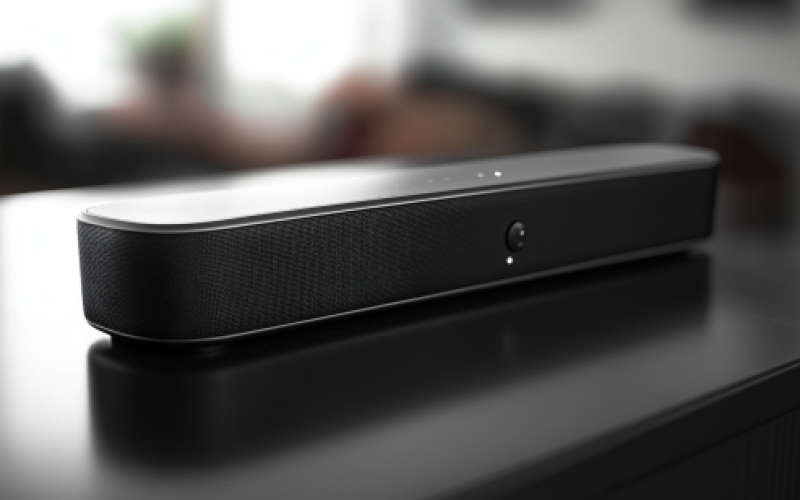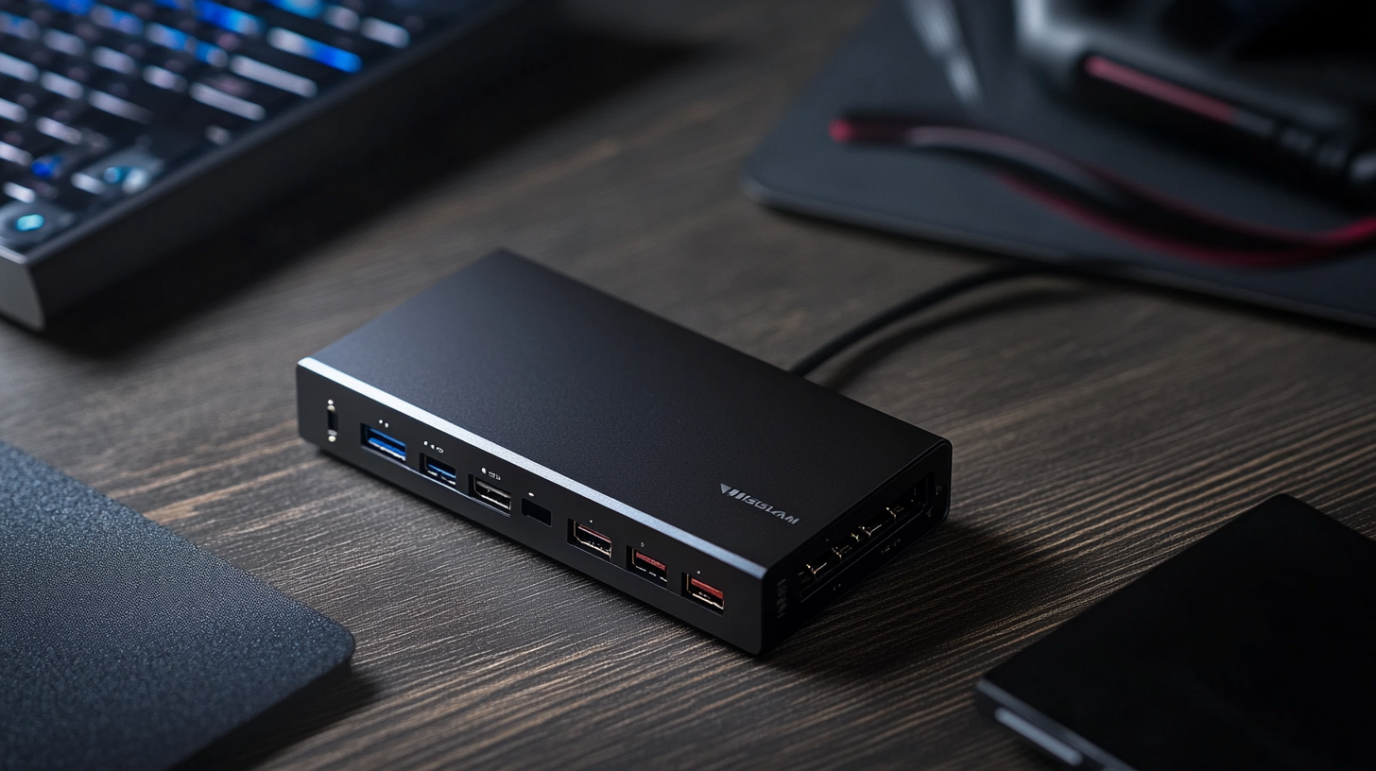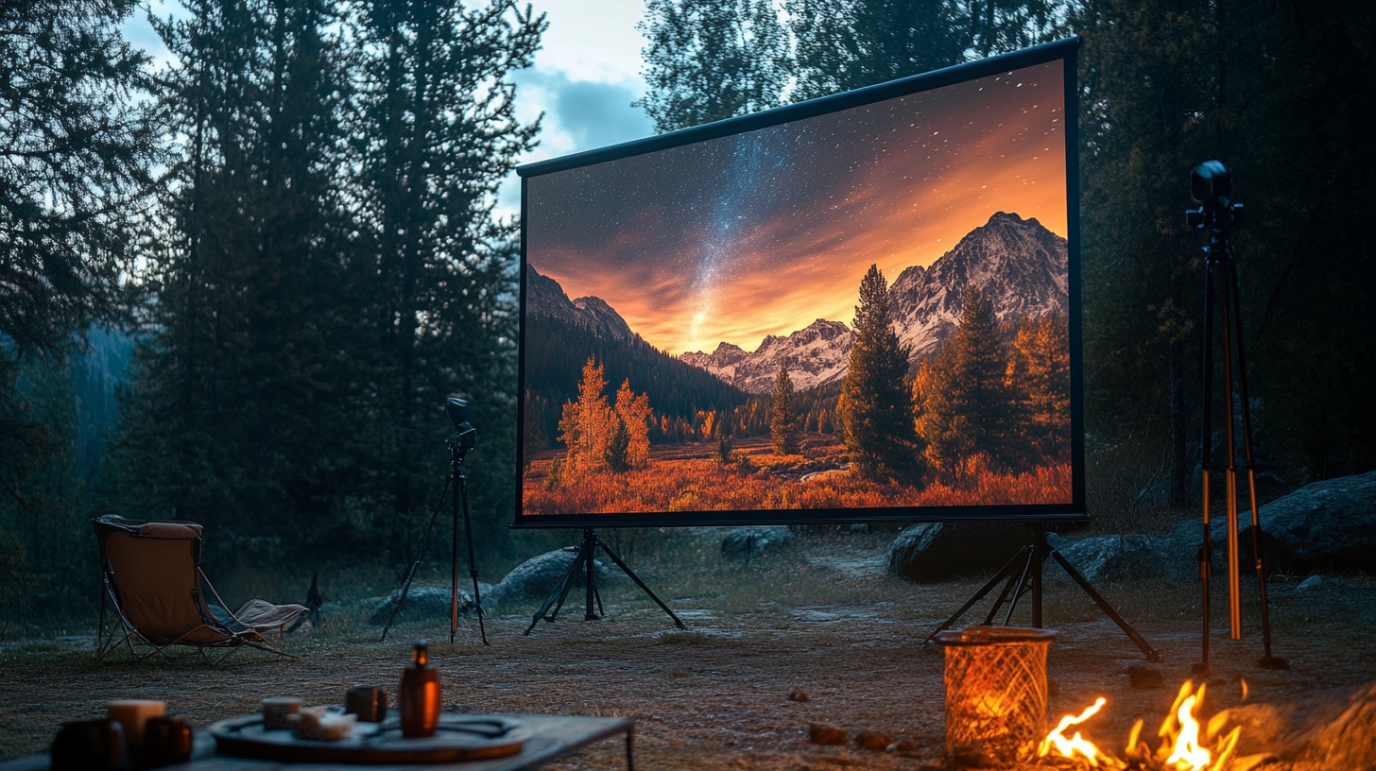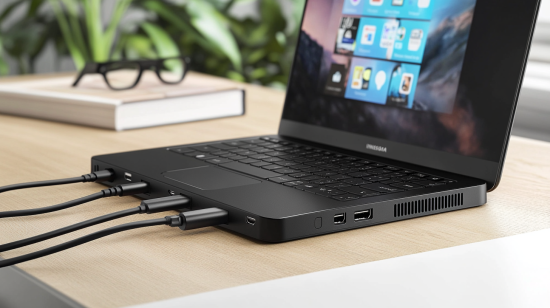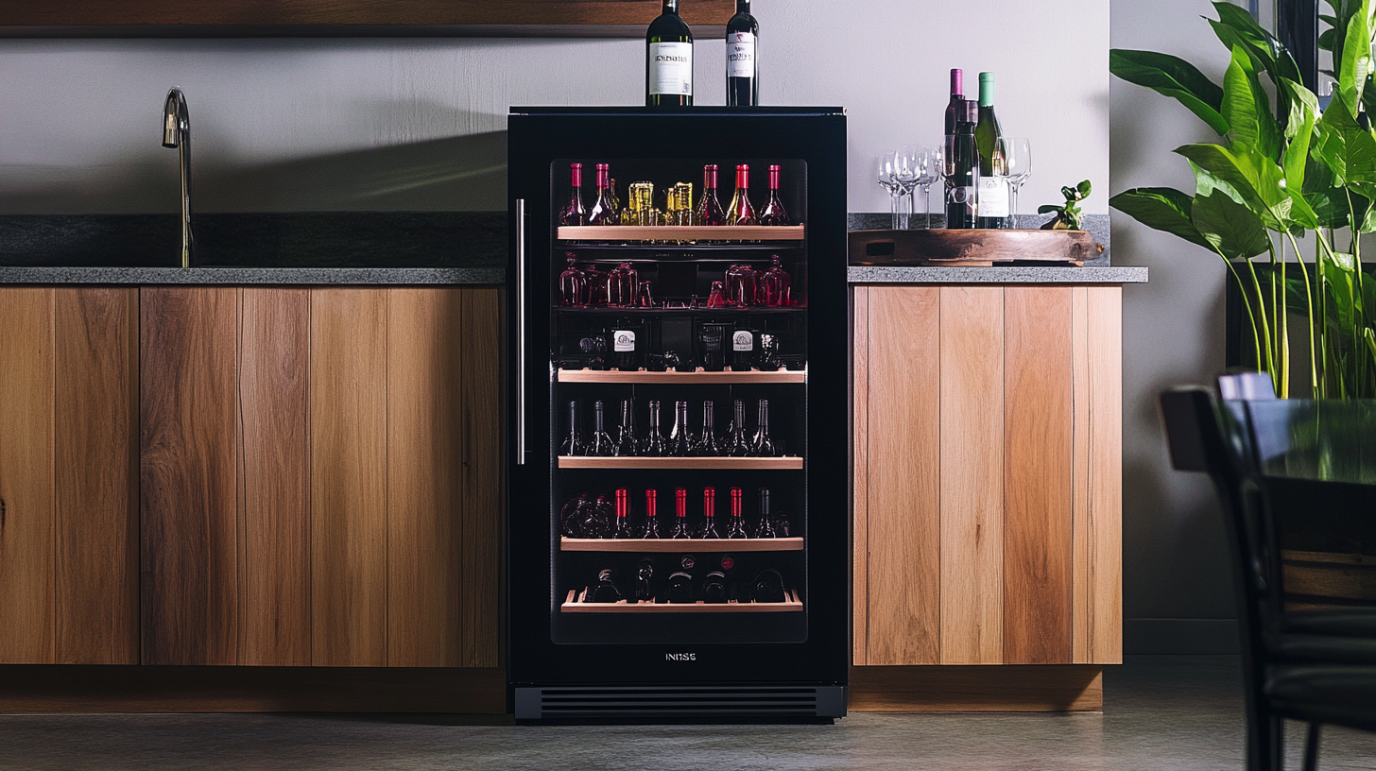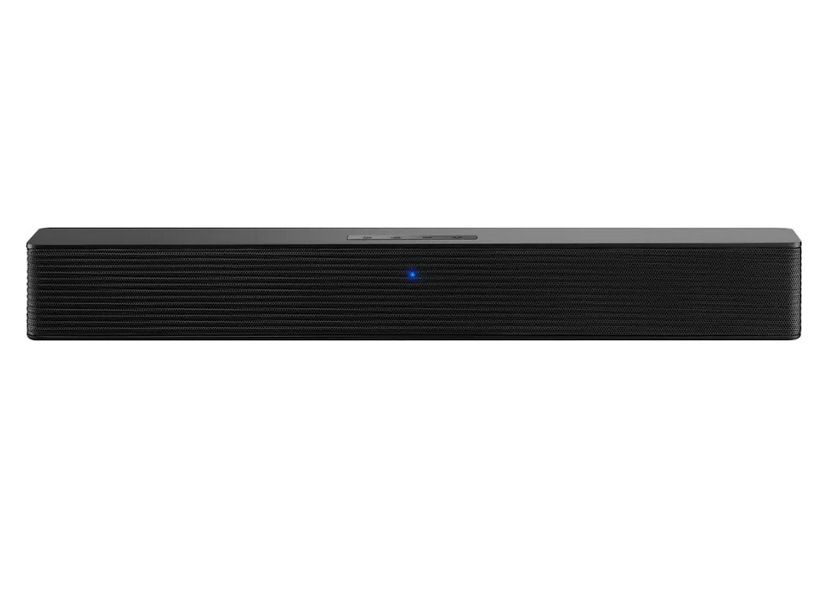
Insignia™ – 2.0 Mini Soundbar 20″ – Black
- 2.0-channel systemLeft and right channels work together to amplify sound.
- Versatile hook-up optionsInput options include digital optical, 3.5 mm AUX, USB, and Bluetooth. Both 6 ft. (1.83 m) digital optical and 3.5 mm audio cables are included.
- Minimal footprintMeasuring 2.58 × 20.08 × 3.11 in. (6.55 × 51 × 7.9 cm), the compact design allows for placement in smaller areas.
- Wall mountableRear side of the soundbar features keyholes for wall mounting.
- Remote control includedGrants wireless control of the soundbar from across the room. Easily power on/off, adjust the volume, change the sound mode, pause/play/skip, adjust the bass, or pair devices using the remote.
- 30W total RMS powerProvides clearer sounding audio.
- Bluetooth music streamingMakes it easy to enjoy tracks stored on a compatible Bluetooth-enabled device (not included).
- Three sound modesChoose between Standard, Theater, or News for a customized audio experience.
- USB portPlug-and-play your WAV or MP3 audio files through the USB port.
$49.99
Transform Your Audio Experience Without Breaking the Bank
Let me be honest with you. I’ve always been that person who rolls their eyes when audiophiles start rambling about sound quality. “It sounds fine to me,” I’d mutter while listening to movies through my TV’s built-in speakers. That was until three months ago when a particularly quiet Netflix documentary had me constantly rewinding to catch the dialogue. After the fifth rewind, I finally admitted defeat. My TV’s built-in speakers were simply not cutting it anymore.
This revelation led me down a rabbit hole of soundbar research, eventually landing on the Insignia 2.0 Mini Soundbar. Now, after living with this compact audio solution for several months, I’m sharing everything you need to know before making your purchase decision. From connectivity options to real-world performance, consider this your comprehensive buying guide from someone who was once just as skeptical as you might be.
Why I Chose the Insignia 2.0 Mini Soundbar
My apartment isn’t exactly spacious. In fact, “cozy” would be the estate agent’s generous description. With limited room and an even more limited budget, I needed something that wouldn’t dominate my living space or empty my wallet. The Insignia 2.0 Mini Soundbar caught my attention because it promised improved audio without the bulk of traditional soundbars.
At first glance, it seemed almost too small to make a difference. How could something barely longer than my forearm possibly transform my audio experience? But the modest price point (under $100) made it a low-risk experiment. If it failed, I wouldn’t be crying over a major investment. Spoiler alert: I haven’t regretted my purchase for a second.
Unboxing Experience: First Impressions Matter
When the package arrived, I was struck by how lightweight it was. Inside, everything was neatly packed and protected—the soundbar itself, a remote control (batteries included, which is always a pleasant surprise), power adapter, 3.5mm audio cable, optical cable, and a concise user manual.
The soundbar itself features a sleek, minimalist design with a matte black finish that blends seamlessly with most decor styles. It’s not trying to be a statement piece—instead, it quietly complements your existing setup. At just 16 inches long, 2.4 inches tall, and 3.2 inches deep, this little unit weighs approximately 2 pounds. I could literally hold it in one hand, which made installation incredibly straightforward.
Setting Up: Even a Tech Novice Can Handle This
I’m not particularly tech-savvy, so I approached the setup with some trepidation. Would I need to decipher complicated instructions or download specific apps? Thankfully, the answer was a resounding no. The setup process was refreshingly straightforward.
For my Samsung TV, I had two options: optical connection or HDMI ARC. I opted for the optical connection since my HDMI ports were already occupied by other devices. I simply:
- Plugged the soundbar into a power outlet
- Connected one end of the optical cable to the soundbar
- Connected the other end to the optical output on my TV
- Turned on the TV and soundbar
- Selected optical input on the soundbar using the remote
Within five minutes, the soundbar was up and running. The manual also provides clear instructions for other connection methods, including Bluetooth pairing and auxiliary connections. Speaking of which…
Connectivity Options: Versatility is Key
The Insignia 2.0 Mini Soundbar surprised me with its range of connectivity options. For such a compact unit, it offers remarkable flexibility:
- Optical input: My preferred connection for the TV
- HDMI ARC: For those who want a single-cable solution
- 3.5mm auxiliary input: Perfect for connecting older devices
- Bluetooth 5.0: For wireless streaming from smartphones and tablets
The Bluetooth functionality deserves special mention. Pairing my phone took seconds, and the connection has remained stable even when I’m moving around the apartment. This has unexpectedly transformed the soundbar into my primary music player as well. The range is impressive—I can control music from my kitchen while the soundbar sits in my living room, approximately 25 feet away.
Audio Performance: The Real Test
Let’s address the elephant in the room—how does it actually sound? After all, that’s what matters most.
The Insignia 2.0 Mini Soundbar delivers a total of 40 watts of power through its two-channel system. Now, 40 watts might not sound impressive compared to premium soundbars with hundreds of watts and multiple drivers, but in the context of my 250 square foot living room, it’s more than adequate.
The most noticeable improvement came in dialogue clarity. Remember that Netflix documentary that had me constantly rewinding? I rewatched it with the soundbar, and the difference was night and day. Voices emerged from the mix with newfound clarity and presence. The soundbar’s vocal enhancement feature specifically targets dialogue frequencies, making every word distinctly audible.
For music playback, the soundbar performs admirably within its limitations. Don’t expect room-shaking bass—there’s no built-in subwoofer, after all—but the low-end is surprisingly respectable for a unit this size. Mid-range frequencies shine, making acoustic performances and vocal-focused tracks particularly enjoyable.
When it comes to movies, the soundbar creates a wider soundstage than I expected. While it doesn’t deliver true surround sound (no mini soundbar can), action sequences feel more dynamic and immersive than they did through my TV speakers. Explosions have more impact, car chases feel more energetic, and background scores add emotional weight without overwhelming dialogue.
Remote Control: Simple Yet Functional
The included remote control is basic but covers all essential functions. It allows you to:
- Power the unit on/off
- Switch between input sources
- Adjust volume
- Toggle between sound modes (Movie, Music, News)
- Adjust bass and treble levels
- Enable/disable vocal enhancement
The remote is compact and lightweight, with clearly labeled buttons that have a satisfying click when pressed. My only complaint is that it’s quite small—I’ve already misplaced it a few times among my couch cushions. I would have appreciated a slightly larger design or perhaps a brighter color that stands out in a dimly lit room.
Sound Modes: Tailored to Your Content
The three preset sound modes might seem like a gimmick, but I’ve found them genuinely useful:
- Movie mode: Enhances surround effects and bass for a more cinematic experience
- Music mode: Balances frequencies for more accurate music reproduction
- News mode: Emphasizes vocal clarity for news programs, podcasts, and dialogue-heavy content
I typically keep it in Movie mode for general TV viewing and switch to Music when streaming Spotify. The News mode has been perfect for those true crime documentaries with whispered narration that previously had me reaching for the subtitles.
Placement Options: Flexibility for Any Setup
The Insignia 2.0 Mini Soundbar can be placed directly in front of your TV on the same surface, or wall-mounted using the built-in keyhole slots on the back. Wall mounting hardware isn’t included, but standard picture-hanging screws work perfectly.
I initially placed mine on my TV stand but later decided to wall-mount it directly below my TV for a cleaner look. The process was simple enough with a drill, level, and two screws. The soundbar is lightweight enough that I wasn’t concerned about it pulling out of the drywall.
One placement tip: if you’re using Bluetooth frequently, ensure the soundbar isn’t placed inside a cabinet or behind obstacles that could interfere with the signal. I initially had mine behind a decorative vase and noticed occasional connectivity issues that disappeared once I moved the vase.
Energy Efficiency: Won’t Spike Your Electric Bill
In our increasingly energy-conscious world, I was pleased to discover that the Insignia 2.0 Mini Soundbar is remarkably efficient. It consumes approximately 40 watts during operation and less than 0.5 watts in standby mode.
The soundbar also features an auto power-off function that activates after 15 minutes of inactivity, ensuring it doesn’t waste energy when not in use. This has been particularly useful for someone like me who occasionally falls asleep during late-night movie sessions.
Price Point: Exceptional Value
Let’s talk money. The Insignia 2.0 Mini Soundbar typically retails between $60-$80, depending on current promotions. Best Buy, as the exclusive retailer for Insignia products, often runs sales that bring the price down to around $50—which is when I purchased mine.
At this price point, I believe the value proposition is exceptional. While audiophiles might scoff at its limitations compared to premium models, the average consumer will notice a dramatic improvement over built-in TV speakers without the sticker shock of high-end alternatives.
How It Compares to Competitors
Before settling on the Insignia, I researched several other mini soundbars in a similar price range:
The Majority Bowfell, priced similarly, offers comparable features but with slightly less power (30W vs. 40W). The TaoTronics soundbar provides similar performance but with a sleeker design at a slightly higher price point. The Amazon Basics 2.0 Channel Soundbar undercuts the Insignia on price but feels noticeably cheaper in build quality.
What ultimately swayed me toward the Insignia was the combination of power output, connectivity options, and Best Buy’s reliable return policy. The brand’s reputation for decent budget electronics also played a role in my decision.
Real-World Performance: Three Months Later
After three months of daily use, how has the Insignia 2.0 Mini Soundbar held up? Remarkably well, I’m happy to report.
The sound quality remains consistent, with no noticeable degradation over time. The physical buttons on the unit still have a satisfying click, and the remote continues to function perfectly. The Bluetooth connection has remained reliable, though I’ve noticed it occasionally takes an extra second or two to pair if I haven’t used it for several days.
Power cycling (unplugging and plugging back in) has solved the few minor glitches I’ve encountered. On one occasion, the sound became slightly distorted after many hours of use at high volume during a party. After letting it cool down and restarting it, the problem disappeared and hasn’t returned.
Where It Falls Short: Being Realistic
No product is perfect, especially at this price point. In the interest of providing a balanced perspective, here are the limitations I’ve noticed:
First, while 40 watts is sufficient for my small apartment, it might feel underpowered in larger spaces. If you have an open-concept living area or a room larger than 400 square feet, you might want to consider something with more power.
Second, the lack of a dedicated subwoofer means bass response is limited. For most content, this isn’t noticeable, but bass-heavy music and action movies don’t have quite the same impact they would with a 2.1 system that includes a separate subwoofer.
Third, there’s no companion app for detailed audio customization. The remote allows basic bass and treble adjustments, but those looking for granular EQ control will be disappointed.
Finally, while the optical and HDMI connections work flawlessly, I’ve occasionally noticed a split-second audio delay when using Bluetooth. It’s barely perceptible and doesn’t affect the viewing experience, but perfectionists might find it annoying for lip-sync-sensitive content.
Who Should Buy This Soundbar?
Based on my experience, the Insignia 2.0 Mini Soundbar is ideal for:
- Apartment dwellers with limited space
- Budget-conscious consumers looking to upgrade from TV speakers
- Those prioritizing dialogue clarity
- Anyone seeking a simple, no-fuss audio solution
- Secondary TVs in bedrooms or offices
- College students in dorm rooms
- First-time soundbar buyers testing the waters
It’s probably not the best choice for:
- Dedicated audiophiles seeking premium sound
- Large living spaces requiring powerful output
- Those wanting true surround sound
- Bass enthusiasts who crave powerful low-end
- Smart home enthusiasts looking for voice assistant integration
Installation Tips from Personal Experience
Having gone through the setup process myself, here are some tips to ensure the smoothest experience:
- Check your TV’s audio output settings: After connecting the soundbar, navigate to your TV’s audio settings and ensure the correct output is selected (optical, HDMI ARC, etc.). Some TVs don’t automatically detect external audio devices.
- Placement matters: For optimal sound, position the soundbar at ear level when seated. If that’s not possible, angle it slightly upward toward the listening position.
- Bluetooth pairing sequence: When pairing with Bluetooth, always ensure the soundbar is in Bluetooth mode before activating pairing on your device. This seems obvious, but it’s a common mistake.
- Remote code for universal remotes: If you’re planning to use a universal remote, the code for most Insignia soundbars is 31517. This saved me from juggling multiple remotes.
- Save the box: If you move frequently like I do, keep the original packaging. The foam inserts perfectly protect the soundbar during transport.
Maintenance and Care
To keep your Insignia 2.0 Mini Soundbar performing optimally, I’ve established a simple maintenance routine:
- Dust the unit weekly with a microfiber cloth
- Check cable connections monthly for secure fit
- Keep liquids away from the unit (learned this the hard way after a close call with a coffee mug)
- Avoid placing objects directly on top of the soundbar
- Periodically check for firmware updates (though these are rare for basic soundbars)
Where to Buy and Current Deals
As an Insignia product, the 2.0 Mini Soundbar is exclusively available through Best Buy (in-store and online). Occasionally, you might find it on Amazon through third-party sellers, but warranty coverage can be questionable through these channels.
Best Buy regularly includes this soundbar in their sales events, particularly:
- Black Friday/Cyber Monday (typically $30-40)
- Back-to-school sales (August)
- End-of-model-year clearance (typically January)
- Random weekend flash sales
If you’re not in a hurry, I’d recommend setting a price alert or checking their weekly ads. The difference between regular price and sale price can be significant—I saved nearly 40% by timing my purchase with a weekend promotion.
The Verdict: A Small Investment with Big Returns
After three months with the Insignia 2.0 Mini Soundbar, I can confidently say it represents one of the best value-for-money purchases I’ve made for my home entertainment setup. While it won’t compete with high-end audio systems costing hundreds more, it delivers exactly what most people need: clearer dialogue, enhanced music playback, and a more immersive movie experience—all in a compact, affordable package.
The most dramatic improvement comes in dialogue clarity, which alone makes this purchase worthwhile for anyone struggling to catch every word in their favorite shows.
For under $100, the transformation in audio quality is remarkable. My viewing experience has improved significantly, I no longer need subtitles for most content, and I’ve even rediscovered my music collection through the surprisingly capable Bluetooth functionality.
If you’ve been on the fence about upgrading from your TV’s built-in speakers but have been intimidated by complex, expensive audio systems, the Insignia 2.0 Mini Soundbar offers the perfect entry point. It’s simple, effective, and represents a noticeable upgrade without requiring an audio engineering degree to set up or operate.
In a world of increasingly complicated and expensive tech, there’s something refreshing about a product that simply delivers on its promises without unnecessary bells and whistles. The Insignia 2.0 Mini Soundbar does exactly that—it makes your TV sound better without breaking the bank or dominating your living space.
And really, isn’t that all most of us are looking for?
Final Thoughts: Three Months Later
Living with the Insignia 2.0 Mini Soundbar has made me realize how much I was missing with my TV’s built-in speakers. Movies are more engaging, music is more enjoyable, and I no longer strain to catch dialogue in softly spoken scenes.
Is it perfect? No. Does it compete with systems costing five times as much? Of course not. But for its intended purpose—providing a significant audio upgrade at an accessible price point—it excels beyond my expectations.
Sometimes the best technology isn’t the most expensive or the most complex—it’s the solution that fits seamlessly into your life and consistently delivers what you need. By that measure, the Insignia 2.0 Mini Soundbar has earned its permanent place in my living room and my recommendation to anyone looking to take their first step beyond built-in TV audio.
If you’ve been putting off upgrading your audio because of budget constraints or space limitations, this little soundbar might be exactly what you’ve been waiting for. Your ears—and your neighbors who no longer hear you constantly rewinding to catch missed dialogue—will thank you.

